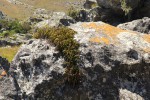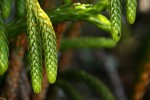Huperzia gnidioides (L.f.) Trevis.
Synonyms |
Lycopodium gnidioides L.f. |
|---|---|
Common name |
|
Description |
Stems pendulous or erect, 2 to 3(-5) times divided, 0.2-1 m long. Foliage leaves 9-15 × 1.5-3 mm, strongly overlapping, linear-oblong to lanceolate in outline, coriaceous, apex ± pointed to sharply rounded, light to dark green, shiny. Fertile area 5-12 x 0.3-0.4 cm. Sporophylls distinctly smaller than foliage leaves, 2-5 × 1.5-2.5 mm, coriaceous, ovate- lanceolate to ovate in outline, apex attenuate. Sporangia kidney-shaped, flattened, hardly covered by the sporophylls. |
Notes | H. gnidioides can be distinguished from H. dacrydioides by having a broad and short fertile portion with sporophylls that are shorter than the foliage leaves; sterile leaves are tightly overlapping. |
Derivation | gnidioides: like Gnidia, a genus in the Thymelaeaceae family which sometimes has similar leaves. |
Habitat | Boulders in montane grassland, shaded rocks near streams, moist evergreen forest. |
Distribution worldwide | Africa, Comoro and Mascarene islands, Madagascar., Seychelles |
Distribution in Africa |
Burundi, Dem. Republic of Congo, Kenya, Malawi, Mozambique, Rwanda, South Africa, Swaziland, Tanzania , Uganda, Zimbabwe. |
Growth form |
Epiphytic, lithophytic. |
Literature |
|



